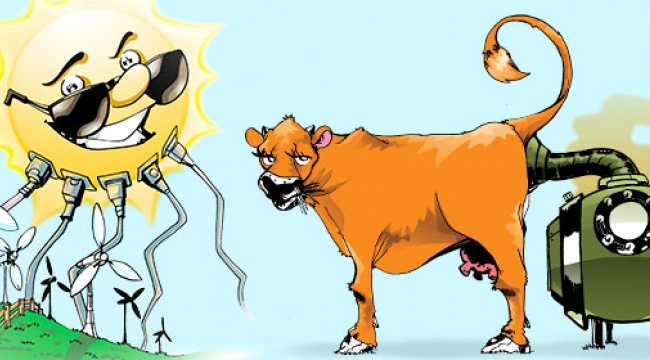While solar panels and windmills may never decorate every home in Calgary, sun and wind will be increasingly relied upon to power our lives.
David Wood is the NSERC/ENMAX Industrial Research Chair in Renewable Energy at UCalgary’s Schulich School of Engineering. He expects the number of wind farms to increase significantly as renewable forms of energy — wind, solar, biofuel, geothermal and more — increasingly replace oil, gas and coal. “We’re going to have to stop using fossil fuels because the world is already suffering serious climate change,” Wood says. (That said, he believes fossil fuels will still be in use in 2067; wind turbines are made from steel, which uses coal. “There are currently no alternatives for that.”)
Likewise, solar power will soon be an essential energy source for Alberta. Jonah Zankl is a fourth-year student in mathematics and economics who once managed UCalgary’s Solar Car Team; he now serves on Fuse Collective, a student organization devoted to sustainability issues. Zankl points to advancements in conductive, transparent film that can be used to glaze windows and harness the sun — a far cry from the clunky solar panels we have now. He expects a growing focus on finding better solutions to bottling and storing sun power. “Putting millions of pounds of lithium-ion batteries around the province may not be the answer,” says Zankl. “We’ll need more efficient ways to store huge amounts of solar power when the sun isn't shining.”
Indeed, the race is already on to develop next-generation batteries: Venkataraman Thangadurai, a UCalgary chemistry professor, recently made news with a safer, leak-proof rechargeable lithium battery the size of a button.
About 10 per cent of Canada’s greenhouse gas emissions are from crop and livestock production. One of those gases is methane, which sticks around for only a decade or two (not hundreds of years like carbon dioxide), but is more than 86 times as effective at trapping heat in the atmosphere than CO2.
We say, put a bag on it by trapping methane — the primary component of natural gas — and using it as green energy. Scientists at Argentina’s National Institute for Agricultural Technology have experimented with this very thing. Tubes are fed into a cow’s digestive tract; they eat, and their gaseous burps are captured in inflatable bags on the animals’ backs. Elsewhere, scientists are trying high-grain diets, fats and oils and anti-microbial agents to reduce ruminants’ emissions.
At the same time, the methane or “biogas” that emanates from the manure generated by cattle, hog and poultry farms can be captured, put through a natural process called anaerobic digestion and used as a renewable energy source. In 50 years’ time, perhaps most Alberta farms will be gas-powered in an entirely different way.
Steven Bryant, UCalgary’s first Canada Excellence Research Chair in Materials Engineering for Unconventional Oil Reservoirs, describes what petroleum production might look like to people flying over Fort McMurray in the year 2067:
“You won’t see any tailings ponds, because we’ve shown that a fascinating class of materials called ionic liquids can remove the slow-to-settle fine solids from those ponds — not in decades, which is the time scale in ponds now, but in hours. This process restores the water in the ponds to its original, uncontaminated state. Scaling up this discovery and developing it into a process that will return clean water to the river and solids into the reclaimed mines could revolutionize our approach to this legacy of oil sands production.
“In fact, ionic liquids can be used to separate solids from bitumen in a process that eliminates the tailings completely, so there’s no need for new ponds when mining oil sands in the future.
“Wells and pipes for producing oil will still be visible because oil will continue to be a useful feedstock for making a variety of chemicals. But facilities for burning natural gas will be gone as alternative, low-to-no-carbon approaches for providing the energy needed to produce that oil will have been implemented.
“And a new type of conduit for carrying energy in new forms — as hydrogen, as electron carriers or as electricity — will have replaced some of the pipelines, as technologies that produce energy while leaving carbon in the ground will have been implemented at large scale. So Fort Mac will still be thriving, but it will bear little resemblance to today.”
← Main Article Next Article →






